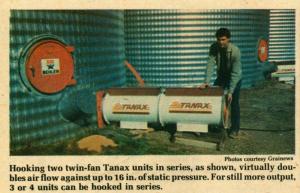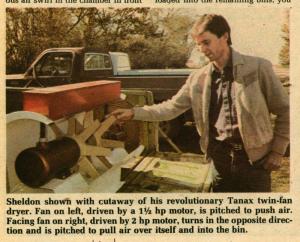Dryer Has Twin Fans
"It'll move twice as much air, yet requires only half as much horse-power," says Sheldon Affleck, Rocanville, Sask., inventor-manufacturer of a revolutionary new drying fan equipped with twin fans that turn in opposite directions.
Unlike conventional axial flow drying fans ù which have one fan inside the housing ù the patented new Tanax from Sheltek Systems has tandem axial fans. One fan, mounted in normal position, is driven by a 1¢ hp electric motor. The second fan, driven by a 2 hp motor, turns in the opposite direction. The facing fans have opposite pitches (one pushes air and the other pulls it) and both turn at the same speed.
"The two fans working together, and turning in opposite directions, can deliver twice as much air into the bin than the same two fans operating separately. Together, they can overcome a static pressure of 8 in. ù compared to only 3 in. for one fan operating alone," explains Sheldon. "The reason for nearly tripling the pressure is because, when one fan is operating alone, there is a tremendous air swirl in the chamber in front of the fan. Consequently, air moving through the fan and into the bin is slowed down. This doesn't happen with the Tanax, thanks to its contrarotating twin fans."
Sheldon notes that his twin-fan Tanax, equipped with 3¢ total hp (a 2-hp motor on one fan and a 1¢-hp motor on the other) delivers 10% more air than a 7 hp conventional (single fan) axial flow fan, yet uses only about half as much electricity. "This is important not only in reducing drying costs, but also in running power to a group of bins," Sheldon points out.
To speed drying and help eliminate a "bottleneck" at the start of harvest, twin-fan Tanax units can be hooked in series. Suppose, for example, you had six Tanax fans, one for each of six bins. At the start of harvest ù when straight combining wheat, corn or some other crop at high moisture ù you could use two fans hooked in series on the first 3 bins to be filled. Or, you could use three or even four Tanax units in series on a single bin. Then, as harvesting progresses and lower-moisture grain is loaded into the remaining bins, you could run one Tanax unit on each of the six bins.
Sheldon notes that the virtual "doubling effect" you get from hooking two Tanax fans in series doesn't hold true with conventional (single fan) axial flow fans. "You get some benefit but it's not nearly as great because of the air swirl problem. And, it doesn't work to put conventional fans in series with one of the units turned backwards in hopes of achieving the Tanax twin-fan effect. The pitch on the turned-around fan would be wrong since it has to pull rather than push air so the two fans work with, rather than against, each other."
Rated output of a single twin-fan Tanax is 3,525 cfm at 4.5 in. of static pressure, 2,978 cfm at 5.3 in., and 2,500 cfm at 5.95 in.
Two Tanax units hooked in series will operate against up to 16 in. of static pressure. At 5.95 in. of static pressure, they produce close to 5,000 cfm, which is almost double the cfm of a single unit. Their combined output is 4,045 cfm at 8.5 in., 3,450 cfm at 10 in. and 2,300 cfm at 12.75 in. of static pressure.
Last fall, Sheldon rigged up a household oil-burning furnace to preheat air going into a Tanax unit. "It worked great, allowing us to dry several batches of grain late in the season when outside temperature was way below zero," Sheldon told FARM SHOW. "Its a great way to speed drying and to stretch your drying season. The beauty of using a household furnace is that it has all the built-in controls for automatic shut-down in case the dryer fans stop."
The new-style Tanax drying unit ù complete with two fans, a 2 hp motor and a 1¢ hp motor ù retails for $1,410 (Canadian).
For more information, contact: FARM SHOW Followup, Sheltek Systems Inc., P.O. Box 324, Rocanville, Sask. S0A 3L0 (ph 306 645-4300).

Click here to download page story appeared in.
Click here to read entire issue
Dryer has Twin Fans GRAIN DRYERS Grain Dryers (29E) 10-1-16 "It'll move twice as much air, yet requires only half as much horse-power," says Sheldon Affleck, Rocanville, Sask., inventor-manufacturer of a revolutionary new drying fan equipped with twin fans that turn in opposite directions.
Unlike conventional axial flow drying fans ù which have one fan inside the housing ù the patented new Tanax from Sheltek Systems has tandem axial fans. One fan, mounted in normal position, is driven by a 1¢ hp electric motor. The second fan, driven by a 2 hp motor, turns in the opposite direction. The facing fans have opposite pitches (one pushes air and the other pulls it) and both turn at the same speed.
"The two fans working together, and turning in opposite directions, can deliver twice as much air into the bin than the same two fans operating separately. Together, they can overcome a static pressure of 8 in. ù compared to only 3 in. for one fan operating alone," explains Sheldon. "The reason for nearly tripling the pressure is because, when one fan is operating alone, there is a tremendous air swirl in the chamber in front of the fan. Consequently, air moving through the fan and into the bin is slowed down. This doesn't happen with the Tanax, thanks to its contrarotating twin fans."
Sheldon notes that his twin-fan Tanax, equipped with 3¢ total hp (a 2-hp motor on one fan and a 1¢-hp motor on the other) delivers 10% more air than a 7 hp conventional (single fan) axial flow fan, yet uses only about half as much electricity. "This is important not only in reducing drying costs, but also in running power to a group of bins," Sheldon points out.
To speed drying and help eliminate a "bottleneck" at the start of harvest, twin-fan Tanax units can be hooked in series. Suppose, for example, you had six Tanax fans, one for each of six bins. At the start of harvest ù when straight combining wheat, corn or some other crop at high moisture ù you could use two fans hooked in series on the first 3 bins to be filled. Or, you could use three or even four Tanax units in series on a single bin. Then, as harvesting progresses and lower-moisture grain is loaded into the remaining bins, you could run one Tanax unit on each of the six bins.
Sheldon notes that the virtual "doubling effect" you get from hooking two Tanax fans in series doesn't hold true with conventional (single fan) axial flow fans. "You get some benefit but it's not nearly as great because of the air swirl problem. And, it doesn't work to put conventional fans in series with one of the units turned backwards in hopes of achieving the Tanax twin-fan effect. The pitch on the turned-around fan would be wrong since it has to pull rather than push air so the two fans work with, rather than against, each other."
Rated output of a single twin-fan Tanax is 3,525 cfm at 4.5 in. of static pressure, 2,978 cfm at 5.3 in., and 2,500 cfm at 5.95 in.
Two Tanax units hooked in series will operate against up to 16 in. of static pressure. At 5.95 in. of static pressure, they produce close to 5,000 cfm, which is almost double the cfm of a single unit. Their combined output is 4,045 cfm at 8.5 in., 3,450 cfm at 10 in. and 2,300 cfm at 12.75 in. of static pressure.
Last fall, Sheldon rigged up a household oil-burning furnace to preheat air going into a Tanax unit. "It worked great, allowing us to dry several batches of grain late in the season when outside temperature was way below zero," Sheldon told FARM SHOW. "Its a great way to speed drying and to stretch your drying season. The beauty of using a household furnace is that it has all the built-in controls for automatic shut-down in case the dryer fans stop."
The new-style Tanax drying unit ù complete with two fans, a 2 hp motor and a 1¢ hp motor ù retails for $1,410 (Canadian).
For more information, contact: FARM SHOW Followup, Sheltek Systems Inc., P.O. Box 324, Rocanville, Sask. S0A 3L0 (ph 306 645-4300).
To read the rest of this story, download this issue below or click
here to register with your account number.








